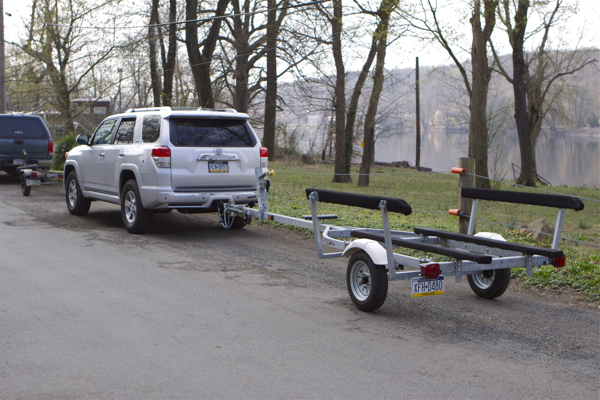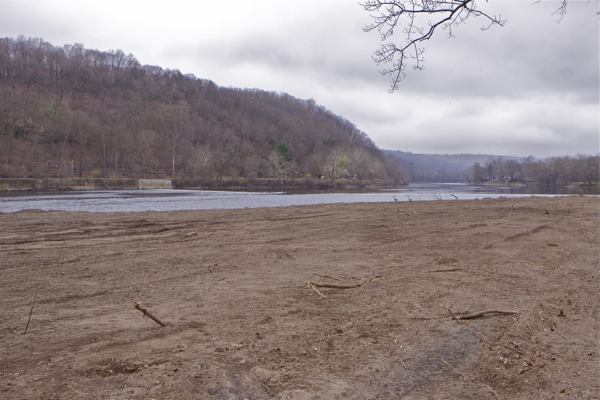
DEP Planning to Remove Scores of Magnificent Old “Dangerous Trees”
An important update on Bulls Island.
DEP Commissioner Martin has not responded to my March 10 letter. I’m not holding my breath.
However, on March 15, DEP issued a press release announcing closure of the campground and a plan to remove “hazardous trees” in response to my March 10 post, which was picked up by the Hunterdon Democrat on March 14.
So, I appeared before the D&R Canal Commission this morning to give the Commission a heads up and ask a few questions about what is going on at Bulls Island. The Commission has regulatory jurisdiction over activities at Bulls Island.
DEP is a member of the Commission and both the D&R Canal Park Supervisor and NJ Water Supply Authority (NJWSA) representatives were in attendance, so I was provided an opportunity to raise issues and solicit info from them.
In response, the Commission agreed to conduct a site inspection in the near future.
Here is what I learned:
There are 3 different projects underway that I have flagged – the third is by far the most significant – after the Commission hearing I went back for more photos:
- maintenance dredging of the D&R Canal by the NJ Water Supply Authority under a US Army Corps of Engineers permit;
- bulldozing of flood debris and sediments along about 400 feet of the river. This was done by NJ WSA crews and is not permitted by USACOE, DEP or the D&R Canal Commission. It is likely that there are several regulatory violations involved;
- a “tree hazard assessment” and emerging plan to cut and remove scores of large old “hazardous” trees.
Canal Dredge
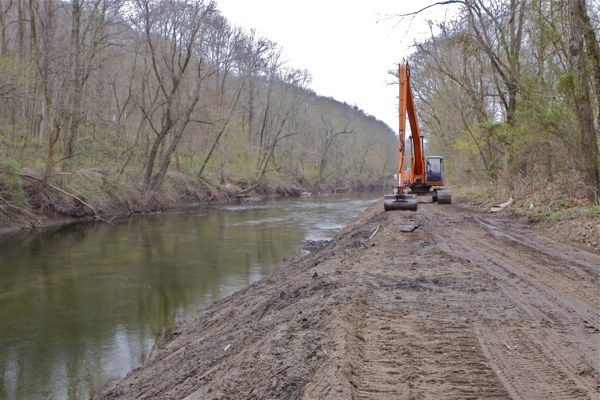
The Commission did not seem interested in pursuing the entire matter and were very reluctant to criticize NJWSA activities.
The Commission felt that this was a routine maintenance dredge operation conducted under a USACOE permit and was routine maintenance they supported.
I asked why there were no drainage or soil erosion & sediment controls in place along the Canal or the river (on 60+ degree slopes) and why equipment staging was done in a way that damaged vegetation, habitat, and soils and caused unnecessary negative visual impacts. No response, so I guess I will have to OPRA the permit.
I did notice installation of a boom along the Canal since I was last there on March 10, but that only captured floatables, not suspended solids and sediments:
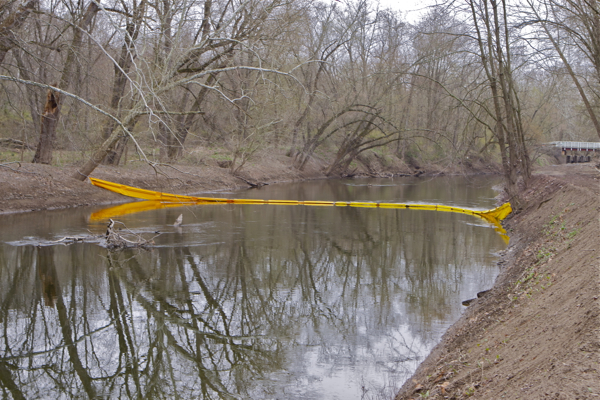
The limitations in the boom are particularly problemmatic for trout, and ironically, DEP trout stocking operations were conducted today in the Canal, about 100 feet downstream from this location:
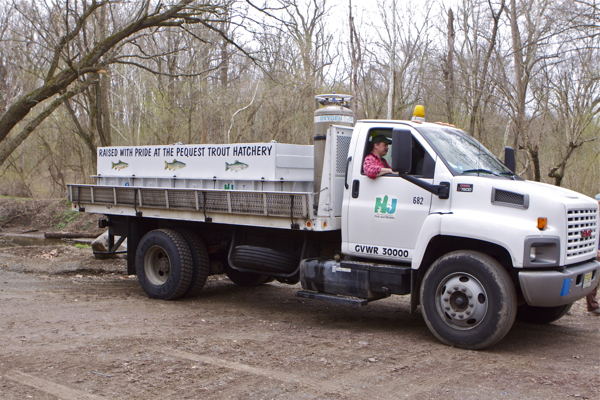
Bulldozing flood debris along the Delaware River
The NJWSA was responsible for the bulldozing operation that killed vegetation and buried tires and other debris along the river. About 400 feet of riverfront looked like a parking lot (see photo above).
Just before I left of the Commission meeting this morning, I got an email from DEP claiming to have conducted a Dash for trash. DEP claimed:
We did sponsor a cleanup at Bulls Island for our AmeriCorps Week -Dash for the Trash event and worked down by the riverbank. A total of 29 volunteers collected 45 bags of trash, 20 bags of recyclables, a foam board, a sink, an old ringer and washer, 10 tires, socks, scrap metal and several plastic tarps.
Take a look at the pictures I shot today – I saw several tires. DEP volunteers may have dashed for trash but they sure missed a lot of tires – and there are no soil erosion/sediment controls, despite fact that soil is bulldozed literally right into the river:
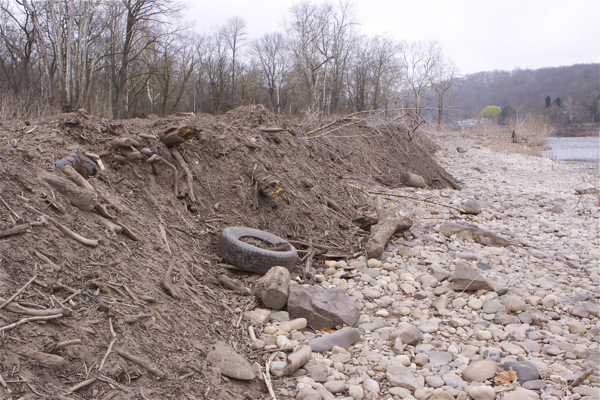
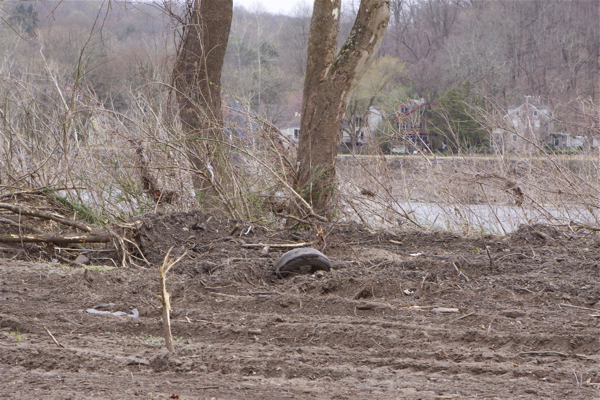
Hazardous Tree Removal Plans
Most important is the pending DEP plan to cut down and remove so called “hazardous trees”
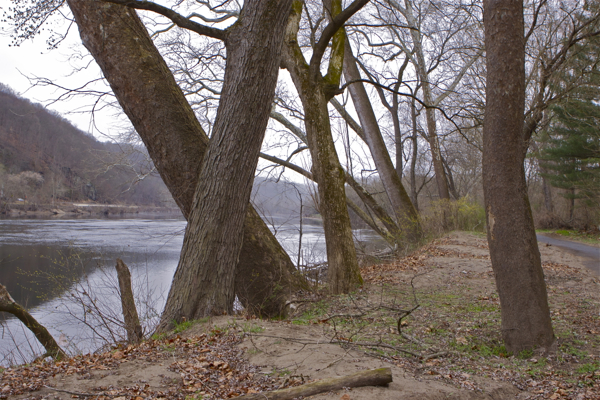
scores of huge old trees slated to be cut and removed
I asked DEP about that. Initially, DEP said that there was litigation so they could not discuss specifics.
But the DEP representative on the Commission (from the Division of Parks & Forestry) did say that DEP hired a professional forester who conducted a “hazard assessment” growing out of last year’s tragic death of a camper. DEP stated that they issued a press release that said the camp ground is closed and “hazardous trees” will be removed.
I asked detailed questions about the methodology, criteria, and standards for such a “tree hazard” assessment. I also asked for their tree removal plan.
DEP refused to respond or divulge any details, so today I filed an * OPRA request for the consultant’s Report (hazard assessment) and DEP plans to remove these trees.
I advised DEP and the Commission that my fear is that many huge old tress will be removed, when there are much less damaging alternative risk management approaches to reduce any legitimate tree hazards.
Tree removal would destroy unique wildlife habitat, especially for birds, harm water quality, especially for trout, and have significantly negative visual impacts to park visitors.
Also, over time, because tree roots hold soil in place, significant tree removal could result in the washout of the entire island during flood events.
Less damaging risk management alternatives include (off the top of my head) closing the campground, removing picnic areas, removing the playground and restrooms, closing the area on windy days or after floods, and limiting public use to walking on trails.
Any tree removal would require D&R Canal Commission approval and possibly DEP permits.
My fear is that the DEP will anticipate controversy and ram it through before public awareness and opposition builds
The Commission will review any DEP tree removal plan before it is executed.
We will keep you posted and strongly urge parks lovers to organize NOW and block this developing DEP disaster before it gain any more momentum.
[* Here is the OPRA request:
On 3/21/12, the DEP representative to the D&R Canal Commission stated that DEP has contracted with a professional forester to conduct a tree hazard assessment at Bulls Island and that hazardous trees would be removed.
The Bulls Island Park Advisory states: “a tree health assessment has found that this area is susceptible to silt buildup from repeated floods that weakened roots of trees in the area.”,
I request all records related to the Bulls Island tree health and hazard assessment, including:
1) the consultant’s tree health assessment report, including identification of dangerous trees and the basis and methodology for that finding;
2) all DEP tree inventory and/or health assessment reports
3) the DEP identification of and plan to remove dangerous trees
4) the DEP plan to restore the site to natural conditions
5) all DEP staff emails, memoranda, correspondence, and telephone records and meeting notes regarding 1-4 above

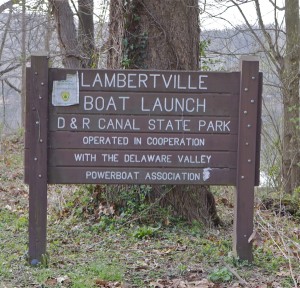 According to the D&R Canal State Park Superintendent, new fees will be imposed on Delaware River access points in D& R Canal State Park at Kingwood, Byram, Bulls Island, and Lambertville.
According to the D&R Canal State Park Superintendent, new fees will be imposed on Delaware River access points in D& R Canal State Park at Kingwood, Byram, Bulls Island, and Lambertville.